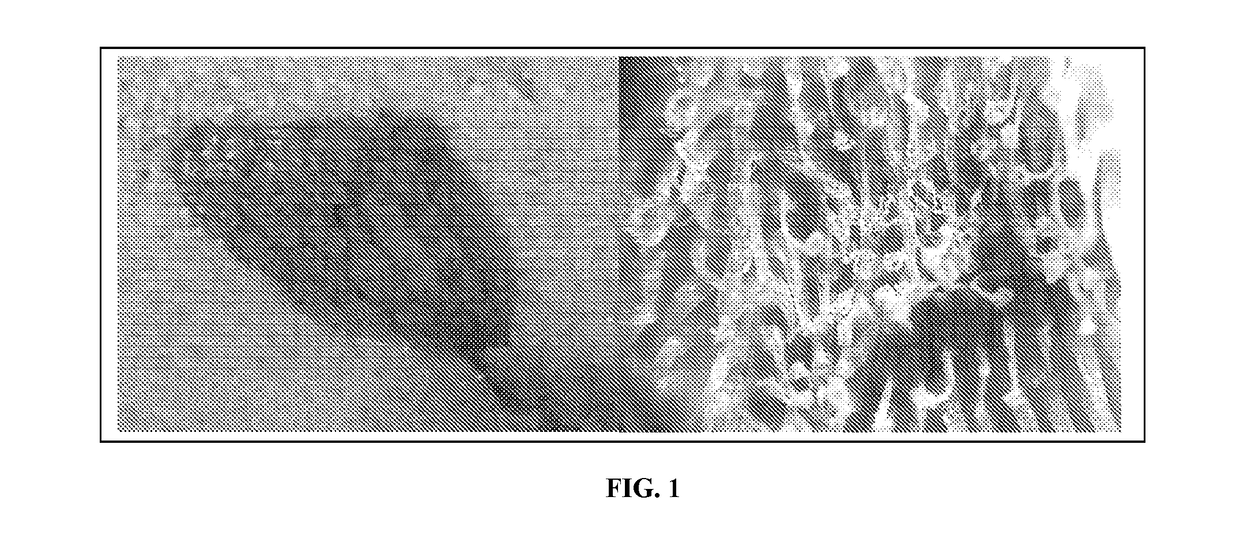Compositions and methods to selectively control species
a species and composition technology, applied in the field of biological and chemistry, can solve the problems of significant environmental, economic and human health problems, loss of native ecosystems and biodiversity, major economic losses, etc., and achieve the effects of preventing growth, reproduction, and/or spreading of multiple target species, reducing environmental pollution, and reducing environmental pollution
- Summary
- Abstract
- Description
- Claims
- Application Information
AI Technical Summary
Benefits of technology
Problems solved by technology
Method used
Image
Examples
example 1
[0114]Elimination, Inhibition, and Prevention of Green Algae by EtOH Extracts of Muskgrass (Chara vulgaris L.)
[0115]General Experimental Procedures:
[0116]Preparation of Experimental Extracts: Experimental Cladophora sp., Pithophora roettleri (Roth) Wittrock, and C. vulgaris were collected from east Texas, United States. The whole plants of C. vulgaris were dried in an oven at 65° C. for 48 h. 2.5 kg of dried plant matter was ground to a coarse powder and extracted two times for 48 h each with 95% EtOH (15 L each time) at RT. The combined EtOH extracts were concentrated under reduced pressure and the total 31.2 g extracts were obtained. The treatment experiments were conducted in the greenhouse (30° C. during the day time and 20° C. at night).
[0117]Injection Experiment I: 100 g C. vulgaris, 10 g crested floating heart (Nymphoides cristata (Roxb.) Kuntze) (Menyanthaceae), and 2 g common bladderwort (Utricularia macrorhiza LeConte) (Lentibulariaceae) were placed in each of six plastic ...
example 2
[0121]Elimination and Inhibition of Seductive Entodon Moss (Entodon seductrix (Hedw.) Mull. Hal.) and Atrichum Moss (Atrichum angustatum (Bridel) Bruch & Schimper) by Their EtOH Extracts
[0122]General Experimental Procedures:
[0123]Preparation of Experimental Extracts: A mixture of seductive entodon moss (Entodon seductrix) (Entodontaceae) and atrichum moss (Atrichum angustatum) (Polytrichaceae) (each accounts for approximately 50% of the total biomass in dry weight) were collected from Nacogdoches, Tex. The whole plant mixture was dried in an oven at 65° C. for 48 h. 180 g of dried plant matter was ground to a coarse powder and extracted two times for 48 h each with 95% EtOH (1.5 L and 1.2 L, respectively) at RT. The combined EtOH extracts were concentrated under reduced pressure and the total 8.7 g extracts were obtained. 3 g extracts were dissolved and suspended in nanopure H2O and prepared as 30 mL experimental solution at the concentration of 10% extracts with 1% surfactant Tergi...
example 3
[0126]Elimination and Inhibition of Giant Salvinia (Salvinia molesta D. S. Mitchell) Plants by Water Extracts of Shredded Fresh Matter of Giant Salvinia
[0127]General Experimental Procedures:
[0128]Extracts Preparation: 22 kg of fresh plants of giant salvinia at tertiary growth stage was shredded, blended, and then placed in a 50 L container with 22 L of tap water in the greenhouse (30° C. during the day time and 20° C. at night). On the seventh day of extraction, a total of 35.5 L of water extracts were collected. The experimental solution is water extracts of S. molesta with 0.5% surfactant Dyne-Amic® (methyl esters of C16-C18 fatty acids, polyalkyleneoxide modified polydimethylsiloxane, and alkylphenol ethoxylate 99%, Helena Chemical Company, Collierville, TN, United States) (v:v).
[0129]Greenhouse Tests: A total of 27 healthy and untreated living plants of S. molesta (in tertiary stage, approximately 8 g in fresh weight each) were cultured and tested in nine plastic containers (14×...
PUM
 Login to View More
Login to View More Abstract
Description
Claims
Application Information
 Login to View More
Login to View More - R&D
- Intellectual Property
- Life Sciences
- Materials
- Tech Scout
- Unparalleled Data Quality
- Higher Quality Content
- 60% Fewer Hallucinations
Browse by: Latest US Patents, China's latest patents, Technical Efficacy Thesaurus, Application Domain, Technology Topic, Popular Technical Reports.
© 2025 PatSnap. All rights reserved.Legal|Privacy policy|Modern Slavery Act Transparency Statement|Sitemap|About US| Contact US: help@patsnap.com



